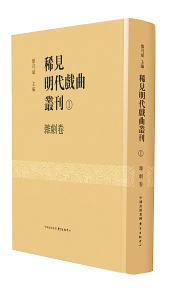New explanations may come from rare and overlooked texts

Rare Dramas from the Ming Dynasty
For a long time, readers have known little about the dramas from the Ming Dynasty. This is because of difficulty accessing the operas’ texts beyond those in several collections including Sixty Plays and Miscellaneous Dramas in the Flourishing Period of the Ming Dynasty. This situation might change due to the recent publication of the eight-volume Rare Dramas from the Ming Dynasty.
With Liao Kebin, a professor of Chinese language and literature from Peking University, presiding over the editing, the compilation of this series has taken 15 years of toil. This series includes 79 operas—42 miscellaneous dramas and 37 romances from the Ming Dynasty. It also records 175 fragmented Ming operas. Lots of rare literature is made public through the publication of this series. It is a remarkable compilation of Ming Dynasty opera literature to be published in the 21st century.
The primary academic value of this series is the rarity of the materials contained in it. Of the 79 operas and dramas included in this collection, at least 28 have never been photocopied, punctuated or collated before. They are the first photocopied editions of the only existing copies of these books or certain editions of these books. The publication will greatly boost the popularization of classical Chinese opera. Certainly, it is meaningful to explore the artistic value of these works and to give a wider public readership.
The fact that some of these operas or dramas have been rarely seen means either that they were rare even in the times when they were written or they were simply been abandoned for not being good enough. However, if these works continued to be kept on the dusty shelves of the library accessible only to a few people, it would be difficult to judge their true value. Even if some of these works were rare because of poor artistic value, the criticism of literary works is not a one-dimensional or once-and-for-all act. New interpretations and explanations of traditional Chinese opera may also be made by keeping pace with the new age. In this sense, the artistic recognition of works rarely seen or those abandoned in previous ages.
The compilation of fragmented operas or dramas is another feature of this collection. Generally speaking, the fragmentation and lost structural integrity of the opera texts is a disadvantage in exploring the aesthetic values of these works. However, sections of these operas and dramas are relatively independent, demonstrating these works’ flexibility. The missing hands of Venus de Milo do not impair her beauty. In summary, this series does some helpful preliminary work by collecting these fragmented operas and dramas.
(edited by CHEN ALONG)
